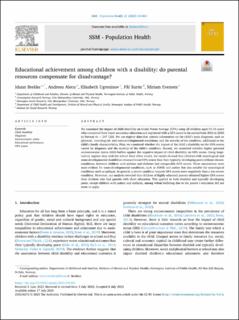| dc.contributor.author | Brekke, Idunn | |
| dc.contributor.author | Alecu, Andreea Ioana | |
| dc.contributor.author | Ugreninov, Elisabeth | |
| dc.contributor.author | Suren, Pål | |
| dc.contributor.author | Evensen, Miriam | |
| dc.date.accessioned | 2023-11-28T07:01:34Z | |
| dc.date.available | 2023-11-28T07:01:34Z | |
| dc.date.created | 2023-09-19T14:59:11Z | |
| dc.date.issued | 2023 | |
| dc.identifier.citation | SSM - Population Health. 2023, 23 . | en_US |
| dc.identifier.issn | 2352-8273 | |
| dc.identifier.uri | https://hdl.handle.net/11250/3104875 | |
| dc.description.abstract | We examined the impact of child disability on Grade Points Average (GPA) using all children aged 15–16 years who completed their lower secondary education and registered with a GPA score in the period from 2016 to 2020 in Norway (n = 247 120). We use registry data that contain information on the child's main diagnosis, such as physical-, neurological- and neurodevelopmental conditions, and the severity of the condition, additional to the child's family characteristics. First, we examined whether the impact of the child's disability on the GPA scores varied by diagnosis and the severity of the child's condition. Second, we examined whether higher parental socioeconomic status (SES) buffers against the negative impact of child disability on GPA scores. Using longitudinal register data with the school fixed-effect model, the results showed that children with neurological and neurodevelopmental disabilities obtained lower GPA scores than their typically developing peers without chronic conditions, however children with asthma and diabetes had comparable GPA scores. These associations were most evident for neurodevelopmental conditions, such as ADHD and autism but also notable for neurological conditions such as epilepsy. In general, a severe condition impacts GPA scores more negatively than a less severe condition. Moreover, our analysis revealed that children of highly educated parents obtained higher GPA scores than children who had parents with short education. This applied to both disabled and typically developing peers, except children with autism and epilepsy, among whom buffering due to the parent's education did not seem to apply. | en_US |
| dc.language.iso | eng | en_US |
| dc.rights | Navngivelse 4.0 Internasjonal | * |
| dc.rights.uri | http://creativecommons.org/licenses/by/4.0/deed.no | * |
| dc.title | Educational achievement among children with a disability: do parental resources compensate for disadvantage? | en_US |
| dc.type | Peer reviewed | en_US |
| dc.type | Journal article | en_US |
| dc.description.version | publishedVersion | en_US |
| cristin.ispublished | true | |
| cristin.fulltext | original | |
| cristin.qualitycode | 1 | |
| dc.identifier.doi | 10.1016/j.ssmph.2023.101465 | |
| dc.identifier.cristin | 2176591 | |
| dc.source.journal | SSM - Population Health | en_US |
| dc.source.volume | 23 | en_US |
| dc.source.pagenumber | 0 | en_US |
| dc.relation.project | Norges forskningsråd: 301666 | en_US |

